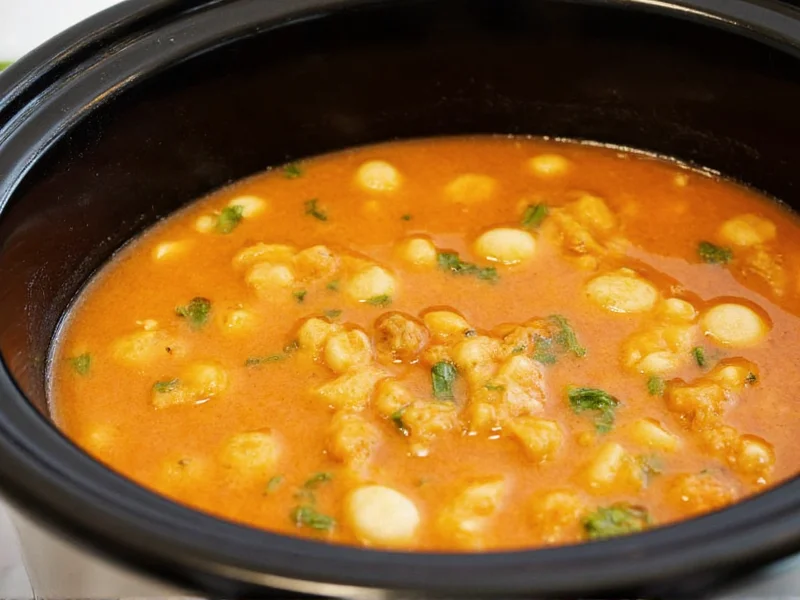Slow cookers transform simple ingredients into deeply flavorful soups through low-temperature, extended cooking. Unlike stovetop methods, slow cookers maintain consistent temperatures that extract maximum flavor from bones, vegetables, and herbs without scorching. This gentle cooking process breaks down tough cuts of meat and fibrous vegetables while preserving delicate ingredients when added at the right time.
Why Certain Soups Excel in Slow Cookers
The magic of slow cooker soups lies in the Maillard reaction and collagen breakdown that occurs during extended cooking. Tough cuts like chuck roast or pork shoulder transform into tender morsels as connective tissues melt into gelatin. Root vegetables develop natural sweetness as complex carbohydrates break down. Unlike pressure cookers that use high heat, slow cookers preserve delicate herbal notes that would evaporate with rapid boiling.
Top 5 Soup Categories Perfect for Slow Cooking
| Soup Type | Best Cooking Time | Key Ingredients | Flavor Development Tip |
|---|---|---|---|
| Hearty Stews | 7-8 hours on Low | Beef chuck, potatoes, carrots | Brown meat first for deeper flavor |
| Bean & Legume | 6-7 hours on Low | Beans, tomatoes, aromatics | Soak beans overnight for better texture |
| Broth-Based | 4-5 hours on Low | Chicken, vegetables, herbs | Add delicate greens in last hour |
| Creamy Vegetable | 3-4 hours on Low | Sweet potatoes, squash, coconut milk | Add dairy at the end to prevent curdling |
| International Styles | 5-6 hours on Low | Tomatoes, spices, proteins | Bloom spices in oil before adding |
Essential Slow Cooker Soup Techniques
Master these professional techniques for consistently excellent slow cooker soups:
Proper Ingredient Layering
Place dense root vegetables like potatoes and carrots at the bottom where heat concentrates. Add proteins next, then delicate vegetables like peas or spinach in the final hour. This prevents mushy vegetables while ensuring thorough cooking of dense ingredients. For bean soups, always place beans above liquid level initially to prevent splitting.
Liquid Ratio Guidelines
Maintain the perfect broth consistency with these ratios:
- For chunky stews: 1 part liquid to 2 parts solids
- For broth-based soups: 3 parts liquid to 1 part solids
- When using frozen ingredients: Reduce liquid by 25%
- For cream-based soups: Add dairy products during last 30 minutes
Remember that slow cookers lose minimal liquid through evaporation compared to stovetop cooking, so you'll need less liquid than traditional recipes suggest.
Three Foolproof Slow Cooker Soup Recipes
Classic Beef Stew with Red Wine
Prep time: 20 minutes | Cook time: 7 hours | Servings: 6
Ingredients: 2 lbs beef chuck (cubed), 2 tbsp olive oil, 1 large onion (chopped), 3 carrots (sliced), 2 celery stalks, 8 oz mushrooms, 3 garlic cloves, 2 cups beef broth, 1 cup red wine, 2 tbsp tomato paste, 1 tsp thyme, 2 bay leaves, 1 lb baby potatoes
Method: Brown beef in batches with olive oil. Place carrots and celery in slow cooker bottom. Add browned beef, mushrooms, onion, and garlic. Mix broth, wine, tomato paste and herbs. Pour over ingredients. Cook on low 6-7 hours. Add potatoes in last 2 hours. Discard bay leaves before serving.
Vegetarian Lentil and Vegetable Soup
Prep time: 15 minutes | Cook time: 6 hours | Servings: 8
Ingredients: 1 cup dried green lentils, 1 onion (diced), 3 carrots (chopped), 2 zucchini (cubed), 1 bell pepper (diced), 4 garlic cloves (minced), 1 can diced tomatoes, 6 cups vegetable broth, 1 tsp cumin, 1 tsp smoked paprika, 2 cups fresh spinach
Method: Rinse lentils thoroughly. Place all ingredients except spinach in slow cooker. Stir to combine. Cook on low 5-6 hours until lentils are tender. Stir in fresh spinach during last 30 minutes. Adjust seasoning before serving.
Troubleshooting Common Slow Cooker Soup Issues
Soup Too Thin
For soups lacking proper thickness, create a slurry with 2 tablespoons cornstarch mixed with ¼ cup cold water. Stir into soup during the last 30 minutes of cooking. Alternatively, remove 1-2 cups of soup, blend until smooth, then return to slow cooker. For bean soups, simply mash some beans against the side of the cooker.
Soup Too Thick
Add liquid gradually in ½ cup increments using appropriate broth, water, or tomato juice depending on your soup base. Remember that soups continue thickening as they cool, so aim for slightly thinner consistency than desired when serving immediately.
Flavor Development Problems
If your soup lacks depth, try these fixes:
- Add 1-2 teaspoons of acid (lemon juice or vinegar) to brighten flavors
- Stir in 1 tablespoon soy sauce or Worcestershire for umami boost
- Add fresh herbs during the last 30 minutes of cooking
- For vegetable soups, include a Parmesan rind while cooking
Advanced Slow Cooker Soup Strategies
Professional chefs use these techniques to elevate slow cooker soups:
Building Flavor Layers
Start with a flavor base by sautéing onions, carrots, and celery before adding to the slow cooker. For meat soups, brown proteins thoroughly to develop fond. Add dried herbs at the beginning but delicate fresh herbs during the last hour. Include umami boosters like tomato paste, soy sauce, or dried mushrooms for complex flavor profiles.
Perfect Timing for Delicate Ingredients
Add ingredients based on their cooking requirements:
- Root vegetables: Entire cooking time
- Beans and lentils: First 5-6 hours
- Firm vegetables (carrots, celery): First 4 hours
- Soft vegetables (zucchini, peas): Last 1-2 hours
- Fresh herbs and greens: Last 30 minutes
- Dairy products: After cooking, when temperature drops below 160°F
Meal Prep and Storage Tips
Slow cooker soups often taste better the next day as flavors meld. Cool soup completely before storing in airtight containers. Most soups keep well for 4-5 days in the refrigerator or up to 3 months frozen. When reheating, add a splash of broth or water as soups thicken when chilled. For best results, freeze soups without dairy or pasta components, adding these fresh when serving.











 浙公网安备
33010002000092号
浙公网安备
33010002000092号 浙B2-20120091-4
浙B2-20120091-4